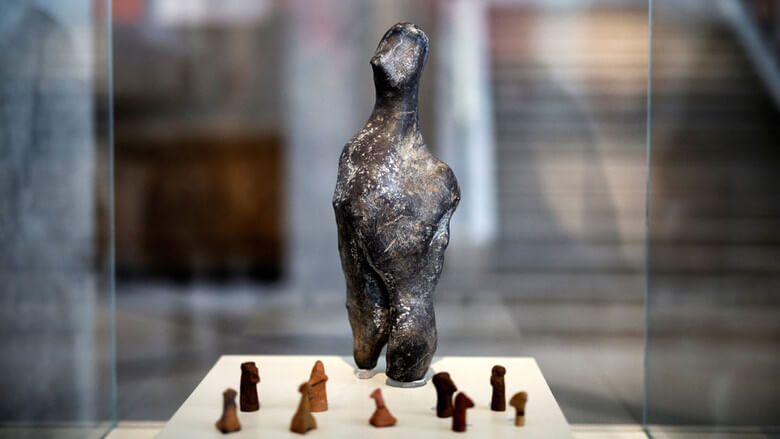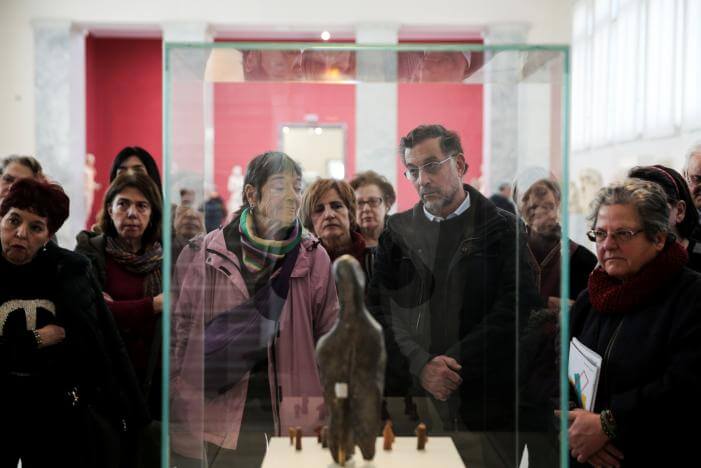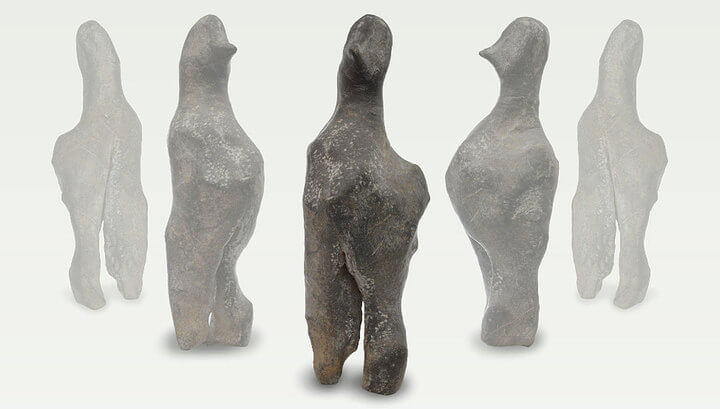
A mysterious granite figurine with a bird beak from the Neolithic period
 09. 12. 2017
09. 12. 2017

The "Seven Thousand Years Old Mystery" was first introduced to the general public. It is the rare case when one single artifact presented on a short-term exhibition was honored with the attention of the Reuters news agency.
We are talking about an extraordinary figure from the Neolithic period, which was named "Seven Thousand Years' Mystery". Scientists have no idea what it represents, who created it, where and why.

The granite figurine, thirty-six centimeters high, was presented together with more typical creations of Neolithic sculpture - small statues made of clay and soft stone. Photo: Alkis Konstantinidis / REUTERS
The bird-faced statuette was exhibited at the National Archaeological Museum in Athens as part of a project called the Invisible Museum, a reference to museum depositories that are inaccessible to the general public and which store almost two hundred thousand ancient artifacts, starting with statuettes and household objects. supplies up to gold ornaments.
A small figurine from the depository, which does not have the grandeur of marble and bronze statues of classical Greece and which might not attract the special attention of visitors in the general exhibition, was exhibited in a well-lit display case. But according to the apt statement of museum archaeologist Katya Manteli, "it is the mystery surrounding this statue that gives it a special charm."
There are really a lot of mysteries. Let's start with the fact that the location of the ancient statue is unknown. She got to the museum from a private collection, but no one knows where she was found. Scientists believe it was made in the north of present-day Greece, in the historic regions of Thessaly or Macedonia.
When? They all say that it belongs to the Late Neolithic period, between 4 and 500 BC. However, unlike the vast majority of sculptures of this period, the figure with a "bird's" face is made of stone, but not of soft pliable rocks such as limestone, but of hard granite. How? That is not clear. In the Neolithic era, there were no metal tools suitable for working hard rocks.

Visitors view 7000 for an old neolithic figure during its temporary exposure at the Hellenic National Archaeological Museum in Athens, Greece, 10. February, 2017. REUTERS / Alkis Konstantinidis
Its size is also unusual, as it measures thirty-six centimeters in height. Neolithic masters, if they made stone statues at all, specialized in the production of small objects. Only 5% of known figures from this period have a height exceeding thirty-five centimeters, and in addition they are all made of soft rocks.
For example, the world-famous Turkish Neolithic "grandmother" from Çatal Höyük, found last year, originated from a local variety of marble. It weighs a whole kilogram, but its height is only seventeen centimeters. In addition, it has well-recognizable shapes, which is certainly not the case with a Greek artifact.
"Maybe it's either a human-like figure with a bird's face, or it's a bird-like creature that has nothing to do with man, but is the embodiment of religious ideas and the symbolism of Neolithic society," says archaeologist Katya Manteli.
Her face is very similar to bird's. It has a sharp nose - beak, big eye sockets, long neck ... There is a distinct small, very "bird" slope of the head. It literally looks like the statue looks thoughtfully at the observer from the bottom up.
The elegant top turns into a massive "elephant" bottom. The long neck overflows into a round belly, but the back of the pieces are unnaturally flat and upright. The legs resemble the poles and they are abruptly "cut off". Perhaps for the statuette to stand upright.

Granite figurine from different angles. Photo: National Archaeological Museum of Greece / namuseum.gr
It is no less strange that this mysterious creature completely lacks any indication of gender. Is it associated with "technical" problems when working with a hard stone, or was it the original intention of the sculptor? On the other hand, the figurine has been polished and this is done only with the finished part.
However, unpolluted places have been preserved on its surface where the original color of stone is visible. Interestingly, these parts are the same as ... call it the intimate zones of the human body. Did not the master have enough skills or appropriate tools to give the figure a more specific, male or female look?
"A round belly may point to a pregnant woman, but the statuette has no sign of breasts. In the Neolithic period, the depiction of the chest clearly and unambiguously indicated a female identification of the artifact. But here are also typically masculine characters. It's amazing, but the statuette is completely asexual, "says Katya Manteli.
According to her, all these oddities make this amusing figure one of the most unique artifacts of the Neolithic era.
After the exhibition, the mysterious statue will return to the public by inaccessible depositories of the National Archaeological Museum of Greece.





 1
1